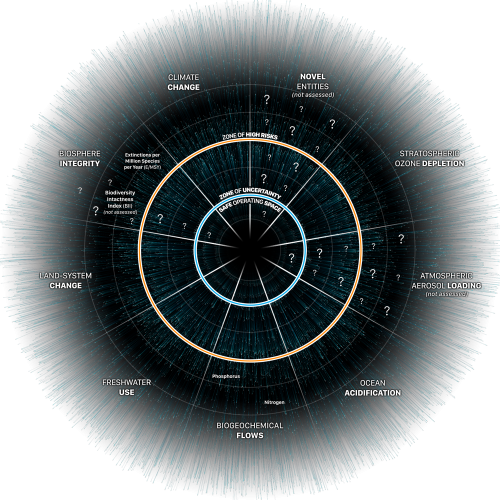Anthropocene Epoch 29/05/2019 – Posted in: Blog – Tags: Anthropocene epoch, Holocene epoch, Sustainable development goal
ANTHROPOCENE EPOCH
Recently (May 21), panel of the Anthropocene Working Group (AWG) voted in favour of designating a new geological epoch — the Anthropocene.
Arrival of new epoch signals the end of the Holocene Epoch, which began 11,700 years ago.
The panel plans to submit a formal proposal for the new epoch by 2021 to the International Commission on Stratigraphy, which oversees the official geologic time chart.
The final ratification will be made by the executive committee of the International Union of Geological Sciences.
Anthropocene Epoch
The term ‘Anthropocene’ was coined in 2000 by Nobel Laureate Paul Crutzen and Eugene Stoermer to denote the present geological time interval in which human activity has profoundly altered many conditions and processes on Earth.
The Anthropocene defines Earth’s most recent geologic time period as being human-influenced, or anthropogenic, based on overwhelming global evidence that atmospheric, geologic, hydrologic, biospheric and other earth system processes are now altered by humans.
The word combines the root “anthropo”, meaning “human” with the root “-cene”, the standard suffix for “epoch” in geologic time.
Anthropocene Phenomena
The phenomena associated with the Anthropocene include an order-of-magnitude increase in erosion and sediment transport associated with urbanisation and agriculture, marked and abrupt anthropogenic perturbations of the cycles of elements such as carbon, environmental changes generated by these perturbations, including global warming, sea-level rise, and ocean acidification, rapid changes in the biosphere and finally proliferation and global dispersion of many new ‘minerals’ and ‘rocks’ including concrete, fly ash and plastics, and the myriad ‘technofossils’ produced from these and other materials.
Global boundary Stratotype Section and Point
The focus is now on identifying a definitive geologic marker or golden spike (technically called Global boundary Stratotype Section and Point) to signal the beginning of the Anthropocene Epoch.
The golden spike must be present globally and should be a part of deposits for geological record.
Many in the AWG believe that artificial radionuclides spread across the world by atomic bomb tests from the early 1950s would serve as the golden spike.
The radionuclides are present almost everywhere — from marine sediments to ice layers and even stalagmites and stalactites.
Planetary Boundary
The Planetary Boundaries concept identifies nine global priorities relating to human-induced changes to the environment.
The science shows that these nine processes and systems regulate the stability and resilience of the Earth System — the interactions of land, ocean, atmosphere and life that together provide conditions upon which our societies depend. Four of nine planetary boundaries have now been crossed as a result of human activity: climate change, loss of biosphere integrity, land-system change, altered biogeochemical cycles (phosphorus and nitrogen).
Two of these, climate change and biosphere integrity, are what the scientists call “core boundaries”.
Significantly altering either of these core boundaries would drive the Earth System into a new state.
Earth’s ”Achilles heels”
Researchers have listed a set of ‘tipping points’ we are in danger of passing in a near future.
Even small human induced climate changes could push these vital parts of the planet over the edge.
These tipping points have been described as Earth’s ”Achilles heels” as they represent areas whose condition decisively affects the entire planet.
Further environmental impact on these “vital organs” of the planet could have large-scale and irreversible effects on the global environment.
Earth Statement
The Earth Statement warns of the unacceptable risks of climate change, identifying 8 essential elements of climate action in 2015 to safeguard human development.
- Commitment to limit global warming to below 2°C.
- Global carbon budget- must be well below 1 trillion tonn CO2 (carbon dioxide).
- Zero Carbon emission by 2050.
- Every country must formulate an emissions pathway consistent with deep decarbonization : Global agreement in Paris.
- 100% clean energy.
- We need a global strategy to reduce vulnerability, build resilience and deal with loss and damage of communities from climate impacts, including collective action and scaled-up support.
- Safeguard carbon sinks and vital ecosystems.
- $100+ billion of Climate finance
Sustainable Development Goals
- No poverty
- Zero Hunger
- Good Health and Well-being
- Quality Education
- Gender Equality
- Clean water and sanitation
- Affordable and clean energy
- Decent work and Economic growth
- Industry, Innovation and Infrastructure
- Reduce Inequalities
- Sustainable cities and communities
- Responsible consumption and Production
- Climate action
- Life below water
- Life on Land
- Peace, Justice and strong institutions
- Partnerships for the goals
Source: The Hindu
You can follow us on LinkedIn and for more updates related to UPSC IAS Preparation, Like our Facebook Page and subscribe our Diligent IAS Youtube Channel
Also Read Related Daily News
- Christchurch Call to Action
- Redefined Units of Kilogram, Kelvin, Mole and Ampere across the World
- Illegal Wildlife Trade
- Coastal Regulation Zone (CRZ) Rules
- Indian Ocean is spawning strong
- Sub-Categorisation of Other Backward Classes




